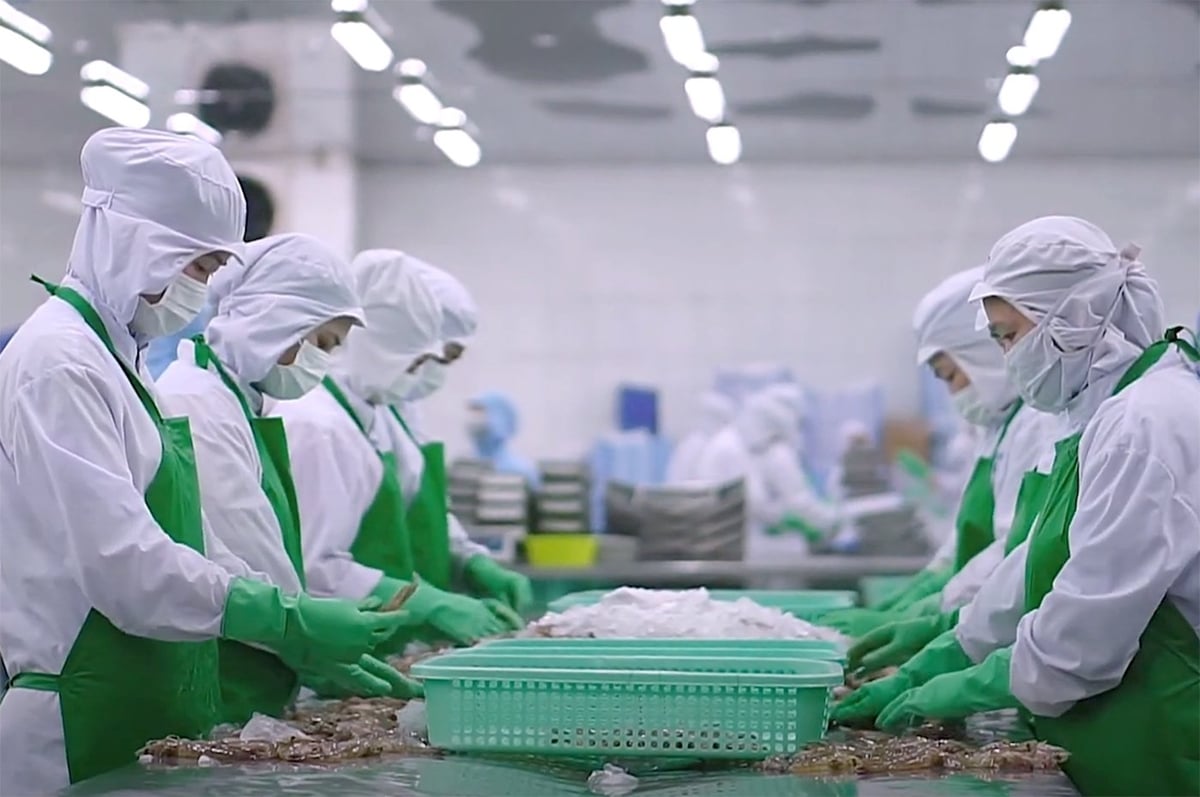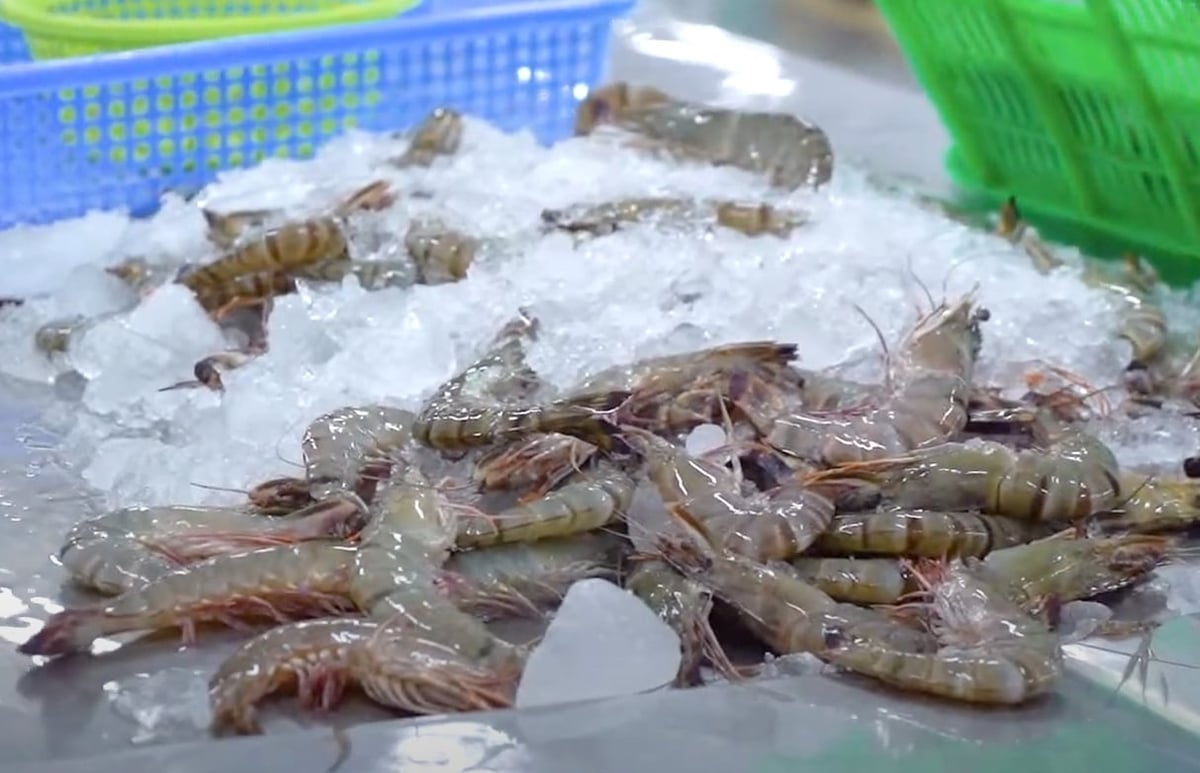December 4, 2025 | 05:55 GMT +7
December 4, 2025 | 05:55 GMT +7
Hotline: 0913.378.918
December 4, 2025 | 05:55 GMT +7
Hotline: 0913.378.918
Speaking about Vietnam’s seafood exports, Ms. Le Hang, Deputy Secretary-General of the Vietnam Association of Seafood Exporters and Producers (VASEP), said that in recent months, seafood enterprises have been highly flexible, seizing the opportunity to ship products to the U.S. before the country officially imposes reciprocal tariffs.
At the same time, many markets have also taken advantage of this pre-tariff period to increase seafood imports. Once the U.S. reciprocal tariffs come into effect, the impact will be felt not only on goods entering the U.S. market but also in other markets such as China and the EU.

Processing shrimp for export at a factory in the Mekong Delta. Photo: Thanh Son.
As a result, seafood exports maintained solid growth in the first seven months of this year. In July alone, exports reached a relatively positive USD 971 million, up 6% compared to the same period in 2024.
However, with the U.S. having officially announced reciprocal tariffs, seafood exports are expected to face significant difficulties and challenges in the remaining months of the year. The 20% reciprocal tariff imposed by the U.S. on Vietnamese goods is far from ideal for the seafood sector, as it will lead to a “tax-on-tax” situation. Vietnam’s two main seafood exports to the U.S., shrimp and catfish, are already subject to anti-dumping duties, with shrimp additionally facing countervailing duties.
According to preliminary results from the U.S. Department of Commerce’s 19th administrative review (POR19) of anti-dumping duties on Vietnamese frozen warm-water shrimp imported into the U.S., the anti-dumping duty for Stapimex is set at 35.29%. This rate also applies to 22 other companies eligible for a separate rate but not subject to mandatory review.
Ms. Le Hang noted that if this preliminary rate is maintained in POR19’s final results, combined with the 20% reciprocal tariff, Vietnamese frozen shrimp imported into the U.S. would face a total tax burden of up to 56%. At such a rate, it would be extremely difficult for Vietnamese frozen shrimp to enter the U.S. market - the sector could even lose this market entirely.

Vietnamese frozen shrimp exports to the U.S. will face major challenges due to the “tax-on-tax” situation. Photo: Thanh Son.
Other leading warm-water shrimp exporters will also face a “tax-on-tax” situation after the U.S. imposes reciprocal tariffs, but at much lower levels. Specifically, Ecuador has an anti-dumping duty of 5% and a countervailing duty of 3.78%; India has an anti-dumping duty of 2.09% and a countervailing duty of 3.78%; Indonesia has an anti-dumping duty of 3.9% and is not subject to countervailing duties.
Ms. Le Hang estimated that due to significant challenges from reciprocal tariffs, seafood exports this year will range from USD 9 to 9.2 billion. If the anti-dumping duty on Vietnamese frozen shrimp is lowered in POR19’s final conclusion, seafood exports could potentially reach USD 9.5 billion.
After the U.S. officially implements reciprocal tariffs, Vietnamese catfish will also face a “tax-on-tax” situation, but with less pressure compared to shrimp, as Vietnamese catfish has virtually no competitors in the U.S. market. In addition, thanks to the positive outcome of POR20, in which seven companies received a 0% duty rate and the largest catfish exporter, Vinh Hoan, was cleared from the lawsuit, Vietnamese catfish can still maintain its foothold in the U.S. market in the near future.
Besides shrimp and catfish, tuna is also a key seafood export to the U.S. According to Ms. Le Hang, after the U.S. announced reciprocal tariffs, other tuna-exporting countries such as Ecuador, Indonesia, and the Philippines faced lower reciprocal tariff rates.
Meanwhile, Vietnam’s tuna industry is grappling with internal challenges in raw material supply, particularly the regulation requiring a minimum catch size of 0.5 meters for skipjack tuna. This combination of tax disadvantages and raw material constraints will make it increasingly difficult for Vietnam’s tuna exports to the U.S., its largest tuna market in the near future.
Facing significant challenges from U.S. reciprocal tariffs, VASEP places high hopes on the flexibility and proactiveness of seafood enterprises in promptly shifting to other markets and taking advantage of opportunities from free trade agreements, especially the EVFTA and CPTPP.
At the same time, VASEP calls on relevant ministries and sectors to promptly address difficulties and bottlenecks related to seafood raw materials (particularly tuna) and VAT on seafood products, thereby enhancing competitiveness and creating more export opportunities for Vietnamese seafood businesses.
On August 12, the Ministry of Agriculture and Environment held the “2025 Agro-forestry-fishery export promotion conference” at the 272 Conference Center in Ho Chi Minh City.
The conference agenda included reports and presentations on opportunities and challenges in the U.S., EU, China, and UAE markets; plans for the consumption of key products in various localities; and discussions and feedback from associations and businesses.
The event was co-chaired by Acting Minister of Agriculture and Environment Tran Duc Thang and Deputy Minister Tran Thanh Nam, with the participation of leaders from various ministries, sectors, associations, and export enterprises.
Translated by Phuong Linh

(VAN) Despite numerous challenges, Vietnam's key seafood products are maintaining strong momentum, setting the stage for full-year exports to potentially reach USD 11 billion.

(VAN) The signing of a protocol between Viet Nam and China on the export of fresh jackfruit represents a significant milestone in agricultural trade cooperation between the two countries.

(VAN) On November 27, the Ninh Binh Department of Agriculture and Environment and the Institute for Green Growth Research organized a training course on greenhouse gas inventory for businesses.

(VAN) China’s cooking oil is suddenly flooding into India. It all comes down to a soybean surplus that Beijing doesn’t quite know what to do with.

(VAN) An Giang promotes supply-demand connections, standardizes quality and builds value chains, creating a foundation for sustainable bird’s nest development and aiming to expand exports.
/2025/11/24/5339-4-nongnghiep-075331.jpg)
(VAN) Recently, the conference on 'Sustainable Fisheries Linkage Chain - Tilapia for Export' took place in Tien Hai commune, Hung Yen province.
/2025/11/21/4309-2-153400_128.jpg)
(VAN) Green and low-emission rice is paving the way for Vietnamese rice to enter high-end markets, marking the beginning of a transformation journey toward greening and elevating the national rice brand.